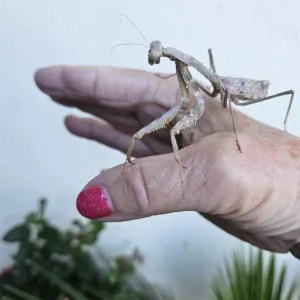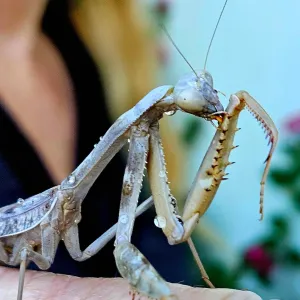Blog article by Paula Pashby
I was watering our Lantana (Lantana camara) bush the other day and saw something moving about on the plant. I stepped closer to take a look and saw what appeared to be two little hands stretching out to grab my outstretched finger. I paused and realized that this creature was also trying to get a better look at my giant size.

The “thing” first appeared to be a 5-inch twig, a mottled wood-bark appearance with barbed arms and dexterous clawed fingers… sort of prehistoric. It had a triangular head with large, bulging eyes and a pin-sized black iris that followed movement. Its head also swiveled 180 degrees to watch wherever I went.
I am sure you have already guessed that I am talking about a “Praying Mantis” (Mantodea), known for its large front legs that are often positioned as though in prayer. While admiring this ancient-looking fellow, my Master Gardener-tempered curiosity took me to the usual question to consider when examining an insect: Is this handsome little creature a friend or foe?
I did some digging and found a few traits of the Praying Mantis:
- It is not a threat to humans or pets, but could cause some irritation if ingested by pets.
- Rarely bites or pinches unless threatened.
- Not harmful to humans or pets.
- Causes minimal damage to foliage where they feed.
The Praying Mantis is a carnivore (flesh eater) and dines mostly on other insects. Their prey includes a menu of flies, mosquitoes, and roaches. However, they are not picky when feeding. According to the University of California Integrated Pest Management program (UC IPM), “Mantids (mantises) feed on any insect they can catch and commonly prey indiscriminately on beneficial and nonpest species, including bees, butterflies, and syrphids (hover flies).”
I landscaped my garden to attract pollinators and wondered if mantises could become a threat. The UC IPM notes that “mantids are relatively inactive, and despite their large size, each individual consumes relatively few insects.”
So, great: have a new friend in the garden that I will be visiting periodically!

You can find more information on the Praying Mantis on the UCIPM website: https://ipm.ucanr.edu/#gsc.tab=0

